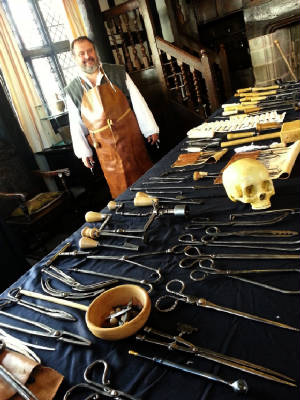|

The Medieval Surgeon
Display of:
- One of the largest displays of
museum quality reproduction surgical instruments ranging from early to late medieval periods. Including instruments
for bloodletting; drawing of teeth and killing the tooth worm; trepanning; cauterising; amputation; arrow removal and
much more.
-Live leeches
-
Facsimilie Surgical Books
- Surgical
Charts (Zodiac Man; Wound Man and Phlebotomy Man )
-Jars of Surgeon's Medicines
- Examples of medieval battle wounds
The surgeon
will explain how particular injuries were diagnosed and how operations were performed, including blood letting; cauterising; the drawing of teeth and treating the
tooth-worm; amputation; trepanning and
the treatment of battlefield injuries and the use of anaesthetics.
(Can
be adapted for specific centuries, for example: 12th, 13th, 14th or 15th Centuries)
The
Tudor Surgeon or
Barber
Surgeon
Display
of:
-One of the largest displays of museum quality reproduction
Surgical Instruments from the Tudor period, including instruments for bloodletting; cauterising; drawing of teeth and killing
the tooth worm; trepanning; cauterising; amputation; arrow and musket ball removal among many others.
-Shaving Instruments (Shaving bowl, combs, scissors, razors)
-Diagnostic
Instruments
-Facsimilie Surgical Books
--Surgical charts , (Zodiac Man, Wound Man and Phlebotomy Man)
-Jars of Medicines
(including the same ointments as found on the Mary
Rose)
-Leeches
- Examples of Battle wounds
The surgeon will explain
how particular injuries were diagnosed and how operations were performed, including removing teeth and amputation, trepanning
and the treatment of battlefield
injuries and the use of anaesthetics. Many reproductions from the Mary Rose are featured.
|

